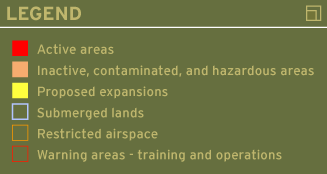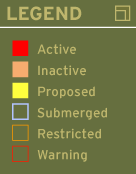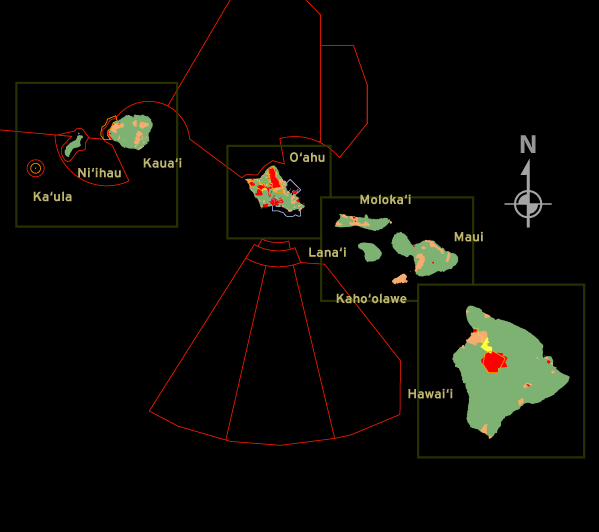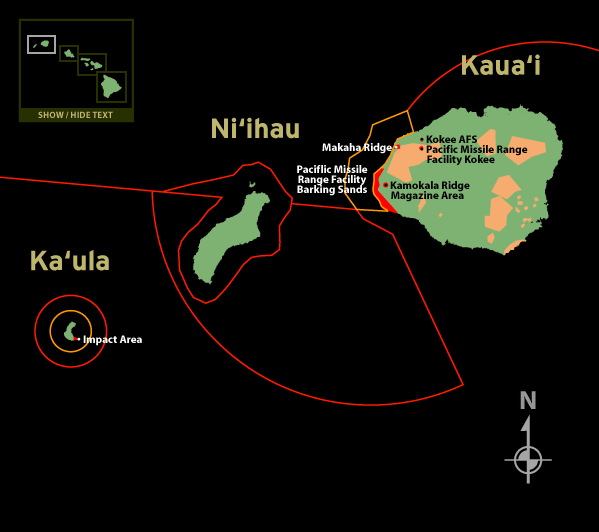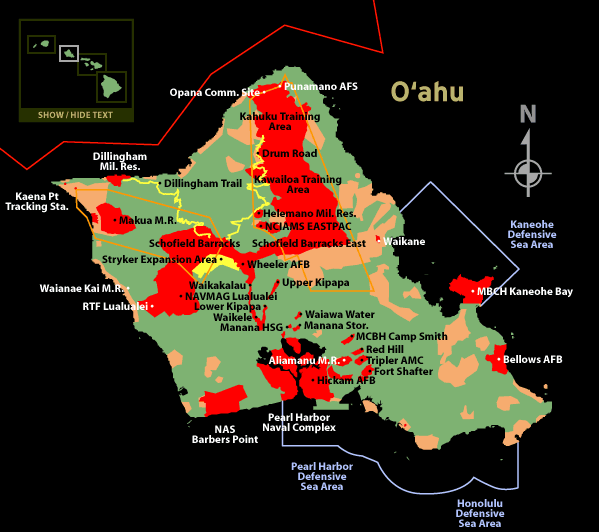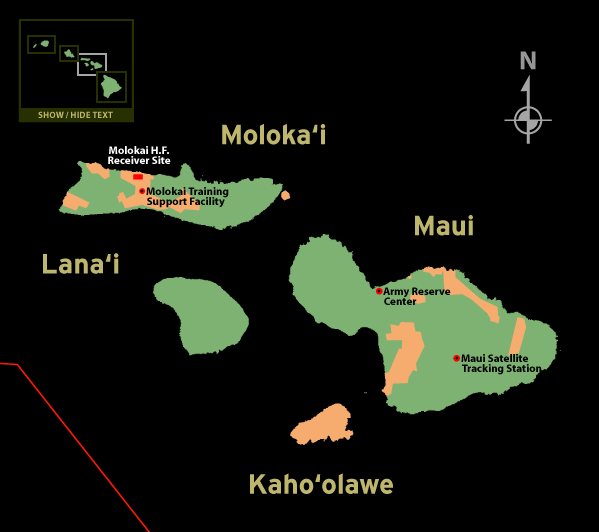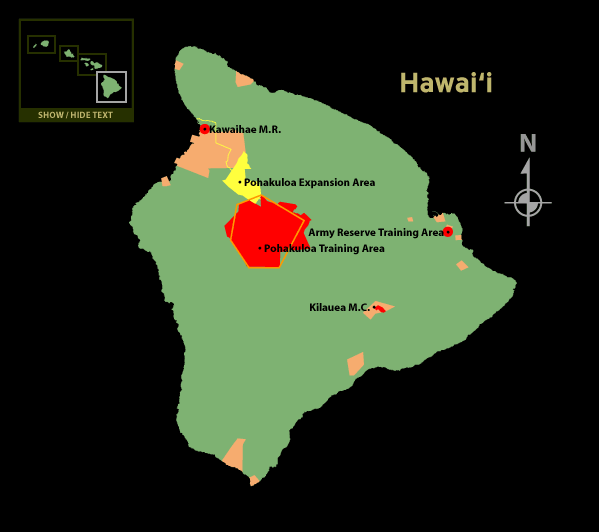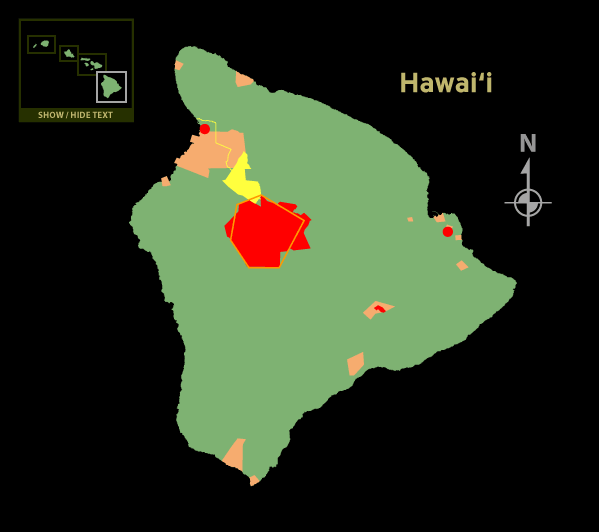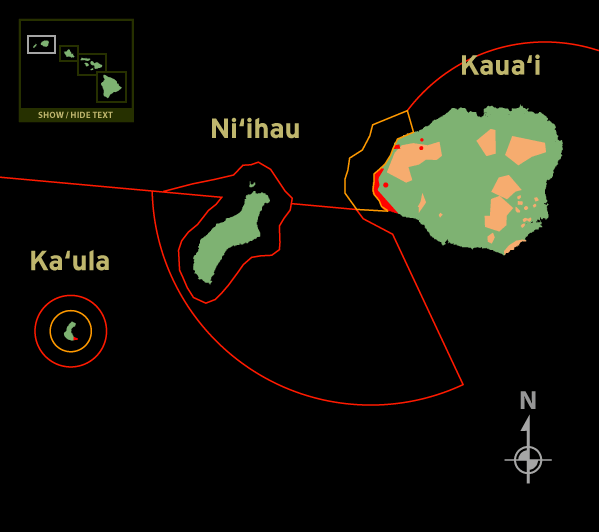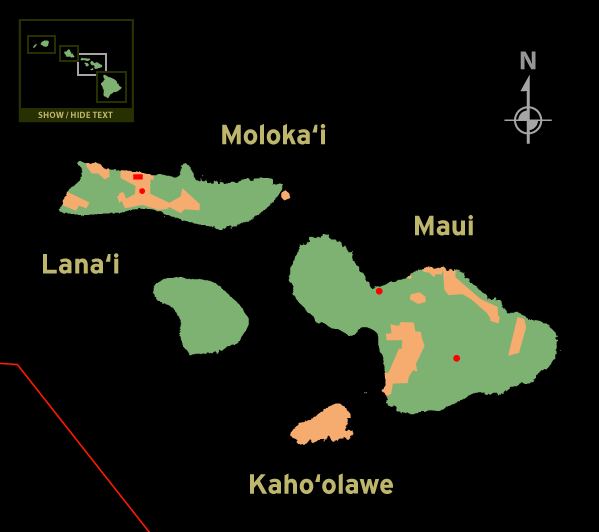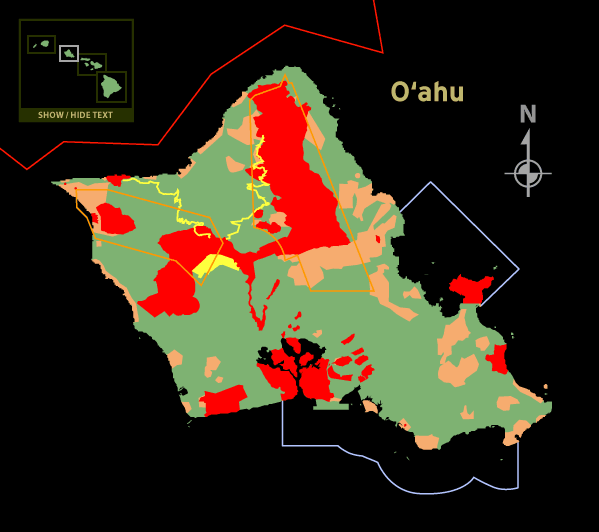
All Islands: The military takes up 20.6% of the total land area of the State of Hawai’i (about 200,000 acres). 56% of these lands are “ceded lands”, or lands once under the Hawaiian monarchy that were granted when Hawai’i was purportedly annexed to the United States in 1898.
Contaminated and former military lands include:
Anahola-Moloa’a Impact Area
Barbers Point Naval Air Station
Center Combat Range
Diamond Head
Fort Armstrong
Fort Kam
He’eia Training Camp
Ioleka’a Training Area
Barbers Point Naval Air Station
Center Combat Range
Diamond Head
Fort Armstrong
Fort Kam
He’eia Training Camp
Ioleka’a Training Area
Ka’u Bombing Range
Kaelepulu Pond Training Area
Kaho’olawe
Marconi Impact Area
Moku Ho’oniki Bombing Range
Pakiki Iki Bombing Range
Pali Training Camp
Pu’u Makakilo Training Area
Kaelepulu Pond Training Area
Kaho’olawe
Marconi Impact Area
Moku Ho’oniki Bombing Range
Pakiki Iki Bombing Range
Pali Training Camp
Pu’u Makakilo Training Area
Sand Island
Wai’ahole Training Area
Wai’anae Training Schools
Waikoloa Training Area
Wailua Impact Area
Waimanalo Training School
Waimea Impact Area
Wai’ahole Training Area
Wai’anae Training Schools
Waikoloa Training Area
Wailua Impact Area
Waimanalo Training School
Waimea Impact Area
In 1995 there were 405 toxic military sites in 122 facilities, with 6 of those facilities on the “Superfund” National Priorities List. As of 1995 the cleanup cost to taxpayers was $1.08 billion.
O’ahu: the military takes up 22.2% of the land on the island of O’ahu (about 85,000 acres). Some of the military occupied sites on O’ahu include:
Aliamanu
Bellows Air Force Station
Camp Stover
Dillingham Military Reservation
‘Ewa Drum Fill / Fuel Storage
Ford Island
Fort DeRussy
Fort Ruger
Fort Shafter
Helemano Military Reservation
Hickam Air Force Base
Hickam Petroleum Storage Annex
Inactive Ship Maintenance Detachment
Iriquois Point / Pu’uloa Housing
Ka’ena Point Satellite Tracking Station
Kahuku Training Area
Kawailoa Training Area
Kipapa Ammunition Storage
Kunia Facility
Makua Valley Military Reservation
Manana Housing
Marine Corps Base Hawai’i Camp H.M. Smith
Marine Corps Base Hawai’i Pu’uloa Training Facility
Marine Corps Base Kane’ohe Bay
Mauna Kapu Communications Station
Mauna Kapu Outlying Facility
Bellows Air Force Station
Camp Stover
Dillingham Military Reservation
‘Ewa Drum Fill / Fuel Storage
Ford Island
Fort DeRussy
Fort Ruger
Fort Shafter
Helemano Military Reservation
Hickam Air Force Base
Hickam Petroleum Storage Annex
Inactive Ship Maintenance Detachment
Iriquois Point / Pu’uloa Housing
Ka’ena Point Satellite Tracking Station
Kahuku Training Area
Kawailoa Training Area
Kipapa Ammunition Storage
Kunia Facility
Makua Valley Military Reservation
Manana Housing
Marine Corps Base Hawai’i Camp H.M. Smith
Marine Corps Base Hawai’i Pu’uloa Training Facility
Marine Corps Base Kane’ohe Bay
Mauna Kapu Communications Station
Mauna Kapu Outlying Facility
McGrew Point Housing
Mokule’ia
Mount Ka’ala Air Force Station
Naval Communications Station, Radio Tower Facility, Lualualei
Naval Communications Station, Radio Tower Facility, Wahiawa
Naval Magazine Lualualei, West Loch
Nu’uanu Cemetery
O’ahu Roads / Trails System
Opana Communications Facility
Palehua Air Force Solar Observatory Research Site
Pearl City Annex
Pearl City Peninsula
Pearl Harbor Main Base
Punamano Air Force Station
Red Hill Fuel Storage Tanks
Schofield Barracks
Tripler Army Medical Center
Wai’anae Kai Military Reservation
Waiawa Gulch
Waiawa Water Supply
Waikane Valley
Waikokalaua Ammunition Storage
Wheeler Army Airfield
Mokule’ia
Mount Ka’ala Air Force Station
Naval Communications Station, Radio Tower Facility, Lualualei
Naval Communications Station, Radio Tower Facility, Wahiawa
Naval Magazine Lualualei, West Loch
Nu’uanu Cemetery
O’ahu Roads / Trails System
Opana Communications Facility
Palehua Air Force Solar Observatory Research Site
Pearl City Annex
Pearl City Peninsula
Pearl Harbor Main Base
Punamano Air Force Station
Red Hill Fuel Storage Tanks
Schofield Barracks
Tripler Army Medical Center
Wai’anae Kai Military Reservation
Waiawa Gulch
Waiawa Water Supply
Waikane Valley
Waikokalaua Ammunition Storage
Wheeler Army Airfield
Hawai’i: the military takes up 4.3% of the land on the island of Hawai’i (about 110,000 acres). Some of the military occupied sites on Hawai’i include the Army Reservation Center on Hilo, Kawaihae Military Reservation, Kilauea Military Camp, and Pohakuloa Training Area.
- More than 400 square miles (250,000 acres) on the island of Hawai’i may contain live arms and other military toxins and should be considered military hazard areas.
- The U.S. Army secretly tested chemical, biological, and deadly nerve gas agents in Hawai’i watershed/forest reserve areas, facts repeatedly denied but later confirmed.
- Currently 7.1 million live rounds of various weapons are fired annually on sacred Hawaiian lands at the Pohakuloa Training Area.
- The Pohakuloa Training Area has the highest concentration of endangered species of any U.S. Army installation in the world.
- The military wants to expand the Pohakuloa Training Area by 23,000 acres, increase the level of training 7 times and number of live rounds fired up to 14.8 million annually.
Moloka’i: Some of the military occupied sites on Moloka’i include the Mokoka’i High Frequency Receiver Site and the Moloka’i Training Support Facility.
Maui: Some of the military occupied sites on Maui include the Army Reserve Center in Wailuku, Kahului Harbor Breakwater, and the Maui Satellite Tracking Station.
Kaho’olawe: The Navy seized the sacred island of Kaho’olawe in 1941 for use in bombing and military maneuvers. A heavy amount of ordnance was used in training on the island for over 50 years until it was turned over to the state in 1994. Although Navy cleanup efforts totalled over $460 million (removing over 9 million tons of scrap metal), ordnance still exists.
Due to the presence of a number of significant cultural sites the entire island was placed on the National Register of Historic Places in 1981. Today the Navy performs the same type of live-fire training used on Kaho’olawe on targets in the ocean.
Kaua’i: Some of the military occupied sites on Kaua’i include Koke’e Air Force Station, Manele Harbor Breakwater, the Pacific Missile Range Facility at Barking Sands, the Pacific Missile Range Remote Radar Facility, and Port Allen Storage Breakwater.
Ni’ihau: Although there are no known active military facilities, in 1997 the Navy considered building two missile launch sites and a 6,000 foot runaway on the island.
Kaula: The military presence on the small island of Kaula consists of the 108-acre Kaula Impact Area, used for training.

